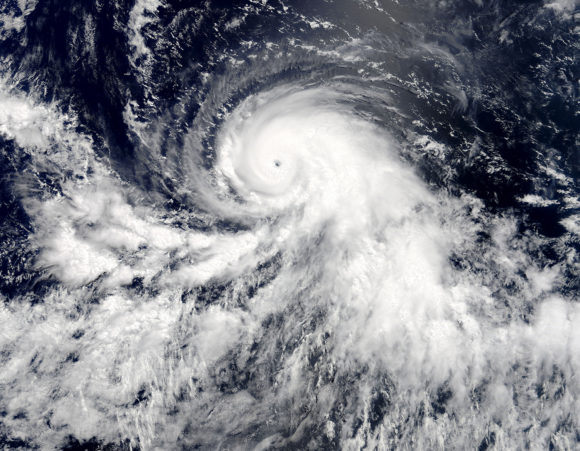Tropical Storm Elsa made landfall in Florida yesterday and is moving to the Northeast at 20 miles per hour, with the National Hurricane Center (NHC) calling for the storm to sweep over parts of the Northeast tomorrow.
Tropical storm warnings have so far been issued for parts of New Jersey, Delaware, Connecticut, Massachusetts and Long Island, New York, meaning that tropical storm conditions are expected somewhere within those warning areas.
According to the National Oceanic and Atmospheric Administration (NOAA), tropical storms are storms with winds between 39 and 73 miles per hour that can bring heavy rain, lightning and significant flooding. Hurricanes are instead classified as storms with winds at or above 74 miles per hour that can cause catastrophic damage from heavy rain, severe flooding, lightning, high winds, storm surge and tornadoes.
While Elsa’s maximum sustained winds are currently near 45 mph, according to NHC, some strengthening could be possible tonight and tomorrow while the system moves close to the Northeastern U.S.
NHC said that across central and eastern North Carolina into southeastern Virginia, as well as from the Mid-Atlantic into New England, two to four inches of rain with isolated totals up to six inches through tomorrow are possible. This could result in flash and urban flooding, as well as isolated minor river flooding. Here’s how East states are preparing:
Virginia
In Virginia, Governor Ralph Northam and the Virginia Department of Emergency Management (VDEM) said in a VDEM press release that they’re closely monitoring the potential impacts of Elsa.
While current predictions indicate the storm will lessen to a tropical depression when it arrives in Virginia, it still has the potential to bring significant rain and flash flooding to eastern and central Virginia, the release said.
“Current predictions indicate that Tropical Storm Elsa may affect portions of Virginia,” said Northam in the release. “We will continue to monitor the forecast and the potential impacts on the Commonwealth, working closely with local governments to support their needs. Now is the time for Virginians to take precautions and make sure they are prepared.”
The Virginia Emergency Support Team (VEST) said it has been communicating with local officials for the past several days in preparation for Elsa’s impact in the state.
“We want to ensure that each locality has the resources they need to mitigate any impacts from the storm,” said Curtis Brown, state coordinator of emergency management at VEST, in the release.
A tropical storm watch is currently in effect for portions of southeast Virginia and the Virginia eastern shore. One to three inches of rain, with locally higher amounts, could lead to scattered flash flooding in eastern and central Virginia. The threat for tropical-storm-force winds also continues to increase across southeast and eastern portions of the state into tonight, and these conditions could linger into tomorrow morning, particularly along the coast, the release said.
New Jersey
New Jersey Governor Phil Murphy said on Twitter that the state is closely monitoring Tropical Storm Elsa, which is expected to pass through certain regions in New Jersey tonight.
The New Jersey Office of Emergency Management said in an advisory that a tropical storm warning has been posted for Atlantic, Southeast Burlington, Cape May, Monmouth and Ocean counties, as well as the Atlantic coastal waters and the lower Delaware Bay. It said rainfall of two to four inches is forecast statewide, and winds may gust 10 to 25 miles per hour inland and 25 to 50 miles per hour along the coast tonight and tomorrow morning.
Maryland
The Maryland Emergency Management Agency (MEMA) also said in a Twitter thread that parts of Maryland can expect excessive rainfall, winds and an isolated tornado.
“Please stay safe, remain vigilant, and use common sense,” the agency said on Twitter.
The Maryland Insurance Administration (MIA) echoed these thoughts on its social media pages, urging residents to make an emergency plan before Elsa hits.
In a June press release, MEMA reminded Maryland residents at the start of Atlantic hurricane season in the U.S. that the National Weather Service and other forecasters have predicted a busier than usual hurricane season this year. This comes on the heels of a 2020 season that saw a record-setting 30 named storms, 14 of which became hurricanes. Tropical Storm Isaias made landfall in Maryland last year, leading to a presidential disaster declaration for the state and three counties.
“As we learned last year, it just takes one storm hitting your area to make a severe impact,” said Russ Strickland, MEMA executive director, in the release.
Pennsylvania
In Pennsylvania, the state’s emergency management agency, PEMA, issued similar warnings to residents about a hurricane season that could see even more activity than last year.
“The National Oceanic and Atmospheric Administration Climate Prediction Center is predicting another above average hurricane season,” PEMA Director Randy Padfield said in a press release issued yesterday. “Any actions to protect yourself from immediate threats to life should take priority, such as evacuating before a hurricane or tropical storm.”
Increasing storm activity, rainfall and record heat events have impacted Pennsylvania over the past decades, with the trend expected to continue, according to climate reports from the state departments of Environmental Protection and Conservation and Natural Resources.
Flooding from heavy rain is the most common topical hazard in Pennsylvania, PEMA said, adding that residents should make sure to have flood insurance regardless of their relation to federally-identified floodplains, as most homeowners and renters insurance policies do not cover this hazard.
Massachusetts
The Massachusetts Emergency Management Agency (MEMA) warned on Twitter that Elsa may bring winds gusts of up to 50 miles per hour on Friday, with the greatest risk in southeastern Massachusetts.
Similar to Pennsylvania, the state urged residents to ensure proper insurance coverage in case of losses.
“Flood losses are not typically covered under renter and homeowner’s insurance, so consider purchasing flood insurance through the National Flood Insurance Plan (NFIP),” the agency said in a press release. “Flood insurance is available whether or not your building is in an identified flood-prone area and can be purchased through insurance agents in most communities. There is a 30-day waiting period before it takes effect.”
Connecticut
In Connecticut, Elsa is forecast to make its closest approach near Stonington around 10:00 a.m. Friday morning as a tropical storm with sustained winds of 50 miles per hour and gusts to 65 miles per hour, the state Division of Emergency Management and Homeland Security said in a press release.
The division added that recent rainfall has saturated the soil in Connecticut and heavy rainfall associated with Elsa will likely cause moderate urban flooding and minor river flooding tomorrow morning. Total rainfall in the state’s affected areas is forecast to range from three to five inches with locally higher amounts possible. The division said that with any tropical system, there is a slight risk of an isolated tornado.
“We are still 23 hours from closest approach and any slight changes in the track forecast would significantly change the impacts for our area,” the division said in the release, adding that it will be closely monitoring Elsa’s progress for any changes.
Delaware
The Delaware Emergency Management Agency (DEMA) along with local, state, and federal partners, is also closely monitoring Tropical Storm Elsa’s progress.
A tropical storm watch has currently been issued by the U.S. National Weather Service for Sussex County with expansion of the watch expected. Additionally, the updated track for Elsa from NHC is slightly further west, which could mean a more significant impact for the state, DEMA warned in a press release.
The main threats anticipated in the state include rain, flooding and increased rip currents beginning late tonight. However, the agency warned that as the state saw with Tropical Storm Isaias last summer, a variety of threats exist including tornadoes, high winds, flash flooding and power outages.
“While current models aren’t showing that the most significant impacts of Elsa will be felt in Delaware, we urge all residents to take steps to reduce property damage and stay safe,” Delaware Department of Insurance Commissioner Trinidad Navarro told Insurance Journal in an emailed statement. “Prepare a space to take shelter in the storm with emergency supplies, fresh water, and fully charged cellphones. Secure outdoor items or furniture that could damage vehicles or property during windy conditions. And, if you have to be out on the roads, never attempt to drive through flood waters.”
DEMA echoed these thoughts in its release, urging Delaware residents to “plan ahead now and be prepared.”
This story will be updated as it develops.
Was this article valuable?
Here are more articles you may enjoy.



 Insurance Industry Impact From Hurricane Beryl Expected to Be ‘Manageable’
Insurance Industry Impact From Hurricane Beryl Expected to Be ‘Manageable’  The Battle Over J&J’s Bankruptcy Plan to End Talc Lawsuits
The Battle Over J&J’s Bankruptcy Plan to End Talc Lawsuits  Catastrophe Bonds Dodge Losses After Beryl Hits Jamaica
Catastrophe Bonds Dodge Losses After Beryl Hits Jamaica  To Insure or Self-Insure? The Question Homeowners Must Answer
To Insure or Self-Insure? The Question Homeowners Must Answer 


